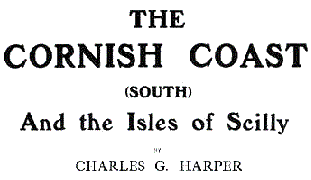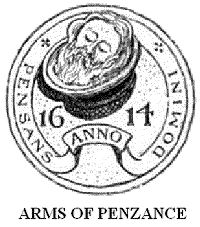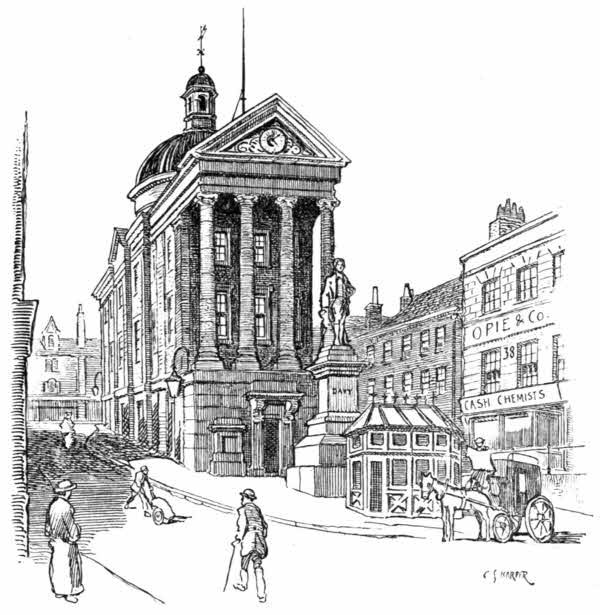Penzance is 279-1/2 miles from Hyde Park Corner, London, by road, and 305-1/4 miles by Great Western Railway. Until some ten years ago, when the Great Western adopted a shorter route, and cut off some of the generous curves with which Brunel had endowed the Cornish portion of the line, the mileage was 328. The name, originally spelled "Pen Sans," and still pronounced so, means Holy Head, or Headland, but there is some uncertainty as to the precise significance. A chapel dedicated to St. Anthony once stood on the bold bluff by the harbour, where the not very satisfactory church of St. Mary, built in 1834, is now situated; and it may have been from this sainted headland that the place-name derived. But for long centuries the Holy Head has been thought that of St. John the Baptist, and when in 1614 Penzance adopted a borough seal [1], it was the head of the Baptist on a charger they selected for the town's device. The old springtime festival, held from distant centuries in the streets of the town, takes place on the eve of St. John the Baptist, and on the eve of St. Peter.
Davy at any rate was a man far more practical than the wiseacres who built the Market House, blocking up the middle of the street just where it is at its busiest, and where traffic pours in from confluent thoroughfares. The ancient market-cross stood until recently at its western end. Penzance market-cross stood until 1829 in the Green Market, but was in that year removed to the corner of a house in North Street [2]. When that house was demolished, in or about 1868, the cross was again moved on, finding a home, appropriately enough, in the west wall of the Market House. There it remained, its inscribed side hidden against the wall, for some thirty years. Loungers leaned lazy shoulders against it, butchers rested sides of meat on it, and it grew, about the head of it, a greasy object. And then some one, in July 1899, hit upon the brilliant idea of removing the cross and cleaning it, and placing it upon a nice new base in the Morrab Gardens, with a metal plate setting forth the year when these things were done. And there it is dripped upon by trees, and although granite is a hard and obstinate substance, yet we have it upon unimpeachable authority that "constant dropping will wear away a stone," and certainly the cross was better preserved by its greasy daily experiences at the back of the Market House than in its present dank situation. Although it is in shape and size (5 feet 6 inches high), just a typical Cornish cross, it is one of the most interesting: the front of it curiously incised with little holes, while the back, hitherto hidden, bears an inscription, which has been read as "Hic procumbunt corpora Piorum."
Beyond this hub of Penzance is the more residential part, Alverton; and Alverton itself is of two quite distinct periods. Firstly, the delightfully quaint and cosy-looking Regency bay-fronted and plaster-faced villas by the Morrab Gardens, and then the modern stone-built residential suburb about Morrab Road. The sea-front is quite casual. It boasts a hotel or two and some more early Regency cottages, and the broad asphalted parade, raised by a few feet above the narrow beach, commands widespread views over the shallow waters of Mount's Bay; but it is not thrust forward by Penzance as a great feature. It just happened, so to speak. Almost coterminous with Penzance is Newlyn, on the west. The name of Newlyn does not indicate "new lake," or indeed, anything new, but derives, like that of Newlyn near Newquay, from St. Newlyna, or Neulwyn, a Breton maiden, who was murdered by a suitor whose love she did not requite. Pontivy Noyala, in Brittany, owes the second half of its name to her.
|

 Penzance is by no means a parasite seaside town, existing only for and
on visitors. It is a busy market-town all the year round, with a considerable
harbour. The long straight thoroughfare of Market Jew Street, rising steadily
to the Market House, which is the centre of Penzance, is a street of shops.
The Market House is a rather gloomy granite building, with a cupola that
bulks out conspicuously in distant views and stands for Penzance. Indeed,
in reminiscences of the place you do not so much as think of the sea-front
as of this extraordinary municipal building, that shows the ideas of Ionic
architecture prevailing in 1837, the time when it was built. The Market
House is, in short, the quintessence of Penzance, and that is the reason
why I have included an illustration of it. Be quite sure it is not for its
beauty, or for the justness of its proportions, nor even for the white marble
statue of Sir Humphry Davy that has stood since 1872 in front of it, on
the site of the house in which he was born. He is Penzance's greatest son,
and was born here in 1778. Philosopher and chemist, and inventor of the
miner's safety-lamp, I dare to believe him a greater and a more practical
man than Sir Isaac Newton. Davy died at Geneva in 1829, and was buried there.
Penzance is by no means a parasite seaside town, existing only for and
on visitors. It is a busy market-town all the year round, with a considerable
harbour. The long straight thoroughfare of Market Jew Street, rising steadily
to the Market House, which is the centre of Penzance, is a street of shops.
The Market House is a rather gloomy granite building, with a cupola that
bulks out conspicuously in distant views and stands for Penzance. Indeed,
in reminiscences of the place you do not so much as think of the sea-front
as of this extraordinary municipal building, that shows the ideas of Ionic
architecture prevailing in 1837, the time when it was built. The Market
House is, in short, the quintessence of Penzance, and that is the reason
why I have included an illustration of it. Be quite sure it is not for its
beauty, or for the justness of its proportions, nor even for the white marble
statue of Sir Humphry Davy that has stood since 1872 in front of it, on
the site of the house in which he was born. He is Penzance's greatest son,
and was born here in 1778. Philosopher and chemist, and inventor of the
miner's safety-lamp, I dare to believe him a greater and a more practical
man than Sir Isaac Newton. Davy died at Geneva in 1829, and was buried there.